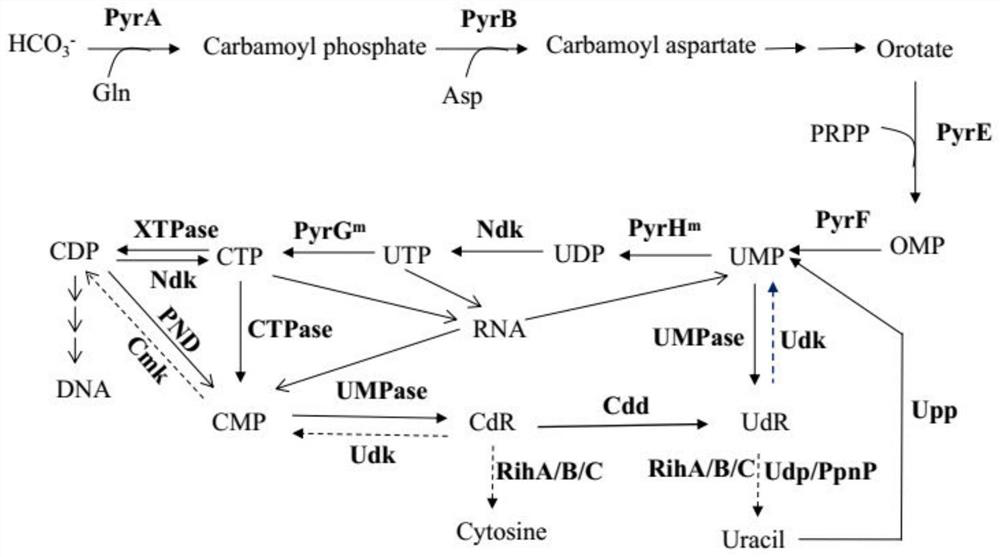Recombinant microorganism for producing uridine and method for producing uridine
A technology for recombining microorganisms and uridine, applied in the biological field, can solve problems such as low yield and unstable fermentation, and achieve high promotion and application value
- Summary
- Abstract
- Description
- Claims
- Application Information
AI Technical Summary
Problems solved by technology
Method used
Image
Examples
Embodiment 1
[0032] Example 1 The method for gene knockout in Escherichia coli
[0033] The present invention adopts Datsenko's method to carry out gene knockout in Escherichia coli (Datsenko KA2000.Proc Natl Acad Sci USA, 97(12):6640~6645), corresponding gene knockout primers see Baba T2006Mol Syst Biol 2(1), 0008.
Embodiment 2
[0034] Embodiment 2 shaking flask fermentation verifies the method for recombinant bacterial strain
[0035] The fermentation medium for verifying that the recombinant strain produces uridine in the shake flask fermentation is specifically 100ml of YC solution, 20g of glycerol, 200ml of 5 times salt solution, 1ml of TM2 solution, 10mg of ferric citrate, and anhydrous magnesium sulfate in each liter of medium 120mg, calcium chloride 111mg, thiamine 1ug, dilute to volume with deionized water. Among them, the 5 times salt solution is 30g per liter of disodium hydrogen phosphate, 15g per liter of potassium dihydrogen phosphate, 2.5g per liter of sodium chloride, 5.0g of ammonium chloride, constant volume with ion water; TM2 solution is tetrahydrate chloride Zinc 2.0g per liter, calcium chloride hexahydrate 2.0g per liter, sodium molybdate dihydrate 2.0g per liter, copper sulfate pentahydrate 1.9g per liter, boric acid 0.5g per liter, hydrochloric acid 100ml per liter. YC solution...
Embodiment 3
[0037] Embodiment 3 5L fermentor utilizes the method for fermenting and producing uridine with recombinant bacterial strains
[0038] Verify that the fermentation medium for recombinant strains to ferment and produce uridine in a fermenter is MF1.16, specifically, each liter of medium contains 10g of ammonium sulfate, 2g of sodium chloride, 2g of potassium dihydrogen phosphate, 2g of magnesium sulfate heptahydrate, and glycerol 25g, calcium chloride 105mg, zinc chloride 10mg, TM2 trace element solution 1mL, ferric citrate 9.4mg, peptone 0-10g, yeast powder 0-10g, dilute to volume with deionized water. Among them, the TM2 trace element solution is 1.31g of zinc chloride, 1.01g of calcium chloride, 1.46g of ammonium molybdate tetrahydrate, 1.9g of copper sulfate, 0.5g of boric acid, and 10mL of hydrochloric acid, and the volume is constant with deionized water. The feeding medium contains 500g of glycerol, 0-10g of peptone and 0-10g of yeast powder per liter.
PUM
| Property | Measurement | Unit |
|---|---|---|
| melting point | aaaaa | aaaaa |
Abstract
Description
Claims
Application Information
 Login to View More
Login to View More - R&D
- Intellectual Property
- Life Sciences
- Materials
- Tech Scout
- Unparalleled Data Quality
- Higher Quality Content
- 60% Fewer Hallucinations
Browse by: Latest US Patents, China's latest patents, Technical Efficacy Thesaurus, Application Domain, Technology Topic, Popular Technical Reports.
© 2025 PatSnap. All rights reserved.Legal|Privacy policy|Modern Slavery Act Transparency Statement|Sitemap|About US| Contact US: help@patsnap.com


